
Like any new experience, your first track day or Super Sprint can be a daunting prospect. In the following article, we'll take the mystery out of Super Sprinting with some guidance on what to expect, how to prepare and some of the things you need to do on the day. With a little more knowledge, hopefully you'll go into the day more relaxed and enjoy the day like a seasoned professional.
So you've paid your entry, organised a day off work and now your waiting for the big day. So... what's next?
Read the RULES: 2024 Championship Motorsport Rules.pdf
Car Preparation
A track day puts a lot more pressure on your car than driving on the street, so its important to make sure your car is in the best possible condition going into the day. You may like to use the checklist attached as a guide or reminder for what you need to service and check, and the items you may want to bring to the track. Of course always check with your mechanic for any specific advice they may have for your car - particularly if it is modified.
Arrive early
Most circuits open at around 7:00am. It’s surprising how quickly the morning passes and before you know it the Clerk of Course will be calling the first group up, so the more time you have to prepare yourself and your car the less stressful it will be.
Select a garage/carport and park your car. If this is your first time to the track or a supersprint try to find someone familiar to park next to who can help you throughout the day – even better if you can arrange this before the day. Any of the club committee members can help put you in touch with someone if you need some help.
Once you've found a garage, it's time to sign on...
Driver Signon
Sign on usually occurs in the control tower, the circuit office, or scruniteering shed, and will generally be open shortly after the circuit opens. Don’t forget to take:
- Club membership card
- CAMS/AASA licence
- Under 18 waiver if required
- Anything else required by the Supplementary Regulations. Eg Registration papers, drivers licence.
At sign on you may be given a coloured wrist band that gives you access to the circuit, and a scrutineering form that you’ll need to take with you when you get your car scrutineered.
Once you’ve signed on, collect your timing device. This is usually from the timing room at the control tower, or may be at driver sign-on. The timing officials will give you instructions on how to mount it, but generally as low as possible, and outside any metal body work - cable tied to the front bumper is a good place.
Prepare for scrutineering
Once you’ve signed on and have your timing device, start preparing your car for scrutineering. Remove all loose items from the interior – floor mats, items in the glove box, centre console and boot, toolkits, spare wheel, etc. Check under the seats. You don’t want items rolling under the pedals as you come to the end of the main straight!
Mount your timer, and any performance/data recorders (VBox) and cameras you may want to use. If your data recorders and cameras have suction cup mounts, they must also be secured by an additional method - called a secondary tether - cables ties work well, or heavy duty fishing line, and must be secured to a piece of the body work or trim that won't come away under load.
Attach your race numbers, blue battery triangle, tow hooks and any other stickers required (eg SubiNats). If you’re using magnetic numbers, tape down the leading edge with electrical tape so they don’t blow off at high speed.
Mount your fire extinguisher - remember it must less than 3 years since its last service date! The scrutineer will take your fire extinguisher out of its bracket to inspect it, so make sure it is mounted securely in its bracket again before going out on track.
Change into your race “suit” – neck to wrist to ankle clothing and shoes. All clothing must be heat resistant and non-flammable – no Nylon!
Once you and your car are “race ready”, drive around to the scrutineering bay and line up in the queue. Don’t forget to take your helmet and scrutineering sheet collected at sign on! Once you’re close to the head of the queue, pop your bonnet and boot/hatch ready for checking and stay with your car.
The scrutineer will check over the car ensuring there are no loose items, brake lights are functioning and the battery is secure. They will check the condition of your helmet, fire extinguisher, seatbelts/harness and other safety items. These must all comply to the relevant standards and be in date. The Supplementary Regulations will describe what is required here, so read them carefully. Remember is it YOUR responsibility to ensure you car is SAFE.
Drivers Briefing
Don’t be late! Listen for the announcement over the PA. The scheduled time will also be in the Supplementary Regulations. It will usually be at the base of the control tower, or somewhere indoors if the weather is bad.Pay attention – the Clerk of Course will be giving you important information about how the day will run, condition of the track and potential hazards that will be important to ensure your safety and the safety of officials and spectators.
Throughout the day
Listen for the announcements over the PA
- Groups are called up to the dummy grid by colour or number
- Listen for messages from the Clerk of Course and scruntineers
Some circuits have a local information radio broadcast that simulcasts the PA system. The frequency may be published in the Supplementary Regulations, or ask at the circuit admin office.
Your first session
This is probably your first opportunity to get out on the track. Take it easy the first lap - it may be a lot slipperier than you think, and there may even be ice on the track in Goulbourn in winter! Make a mental note of where the flag points are as its important that you observe the directions given by the Flag Marshalls throughout the day. Take notice of racing lines, braking markers, etc. Its a great idea to follow a more experienced driver the first time out, as you'll quickly get a good feel for the correct racing line this way.
After each session
When you come off the track, take a lap or two around the paddock if you can. This will help cool everything down, particularly your brakes with some airflow.
When you return to your garage, don’t apply the handbrake. You may warp your rear discs, or worse the brake pads may bind to the discs. Instead chock one of the wheels so your car cannot roll.
Once your car cools down, there are a few important things to check...
Check your oil and coolant overflow after each session.
Check your oil and coolant overflow after each session!!
Check your oil and coolant overflow after each session!!!!
Yes it is that important! One of the common causes of big end bearing failure on a Subaru is oil starvation. Make sure your oil is always topped up - Subaru's can lose oil via "blow by" under boost, particularly if you're running higher boost than standard.
Re-Torque your wheelnuts throughout the day. They CAN come loose with heat cycling, and you don’t want to be THAT guy whose wheel falls off half way down the main straight. Noone wants that video of themselves to go viral!
Monitor tyre pressure. Each Manufacturer and each tyre has a recommended hot pressure, but around 34 PSI hot is a good ballpark starting point. You might let as much as 10PSI out of your tyres compared to the street during the day, so check pressures as soon as you come off the track for the first 2 or 3 sessions. Don’t forget to re-inflate them at the end of the day before you drive home!
Manage your heat.
A street car with standard brakes, standard cooling, and street tyres, is not designed to cope with hot lap after hot lap. Use your first lap out each session as a warm up, and then manage your hot laps sensibly. After a couple of laps your tyres may start to lose grip, and your brakes may start to fade. So follow one or two hot laps with one or two cooling laps, and repeat if there’s still time in the session. If you’re on a hot lap and you make a mistake, are held up, etc, back off and let the car cool down – you’re not going to set a good time, so recover and set yourself up for your next hot lap.
What do I do if I spin off?
A track day is the perfect place to explore the limits of your car and your abilities and learn how to improve both. Although spinning or going off the circuit is not encouraged, it is an inevitable part of learning and pushing your limits. When it happens, slow the car down and compose yourself. Don’t look at the wall you’re heading towards, look for your safe exit point and drive towards that instead! If you watch the wall you’re going to hit it!! Remember the grass can be very slippery, especially in the wet, so be prepared and don’t panic. Watch for approaching traffic, and only rejoin the circuit when it is safe to do so, and remember to take it easy once you rejoin – your tyres will be dirty and your grip level will be significantly reduced for the next few corners!
What do I do if I have an accident or need to stop on track?
Accident
Stay in the car and wait for the medical team to arrive. They will assess you and make sure you have no injuries and it is safe to move.
Fire
There are flag points with fire extinguishers at several locations around the track, and throughout the pits/paddock. If you have a fire try to stop close to one of these. As soon as they notice you're in trouble, the Clerk of Course will red flag the session and deploy the Fire/Rescue team.
If you expect a fire in the engine bay don’t lift your bonnet! The rush of air will fan the flames and may cause a fireball. Having no eyebrows is not a good look for anyone! Keep your safety gear on and use your extinguisher through any gap you can poke it through!
Breakdown/Mechanical Failure
If you suffer a mechanical failure on track, slow down, stay off the racing line, and pull off the track as soon as it is safe for you to do so. Oil and other fluids on the track can be difficult for officials to see from the side of the track and create a hazard for other drivers, and delays in the day cleaning it up. If you can't pull into a safe position, or through an escape road, stay in your car with your belt/harness on and wait for recovery to arrive. You are safer in your car than you are walking around! If you’re in a safe position the Clerk of Course may wait until the session is complete before sending recovery to assist you, so sit tight.
Officials
The officials are there to keep the day running smoothly and watch out for the safety of drivers, other officials and spectators. It takes many officials to run a super sprint, and in most cases they are all volunteers who want to enjoy the day as much as you do. The aim is for everyone to go home at the end of the day having had a great time, so listen for their instructions - they're there to help you.
| Clerk of Course | The Clerk of Course and Assistant Clerk of Course coordinates and is responsible for all the activity on the track, the safety of competitors and officials. | |
| Event Secretary | The Event Secretary is the administrator of the event. They're the person who takes your entry and organises all the necessary permits for the day. | |
| Scrutineers | The role of the Scrutineers is to check that your car complies to any rules of the day (detailed in the Supp Regs) and that you have the required safety equipment. Note that is it NOT the role of the scrutineers to ensure your car is SAFE - that is your responsibility - however they will point out if they identify something that could be an issue, and may ask you to resolve it before you'll be allowed onto the circuit. | |
| Flag Marshalls | Flag Marshalls relay signals to the drivers on track via Flags from various points around the circuit. Its important to familiarise yourself with the location of the flag marshes during your first warm up lap. |
Flags are used at various points around the circuit to inform drivers of what is happening around them on the track. They can be shown either motionless or waved. A waving flag emphasises the flag's basic meaning. Some circuits, such as Wakefield Park, use a lighting system (similar to most GoKart tracks) instead of the Yellow, Green and Red flags.
Typically a super sprint will only use the Yellow, Green, Red and Chequered Flags, but you may see the others from time to time if the need arises.
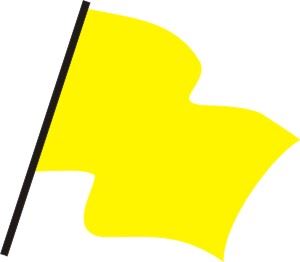 |
Yellow flag: The yellow flag signals a situation of danger ahead. Drivers must slow down and show extreme caution. Drivers may not overtake other vehicles until they have passed the green flag. |
|
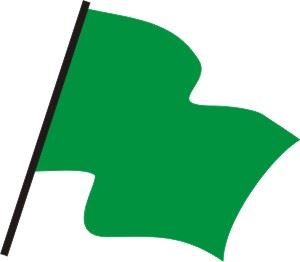 |
Green Flag: All clear signal. It is used at the end of the danger area controlled by yellow flags. Drivers may continue on at race speed. It can also be used to signal the start of a warm-up lap or practice session. |
|
 |
Blue flag: Overtaking signal. The blue flag informs the driver that he is about to overtaken by one or more faster cars. When the flag is waved, it draws the driver’s attention either to the closeness of the car about to overtake him, or to the high speed at which it is approaching. The blue flag can be shown motionless when the faster car is still some distance away but approaching quickly. |
|
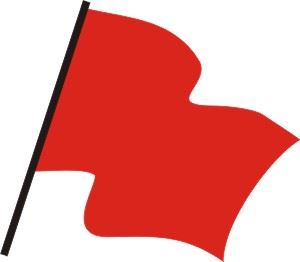 |
Red Flag: Session stopped. The red flag will be shown at all posts on the circuit when the Clerk of the Course has decided to stop the race or practice session due to a hazard effecting the course. All drivers must stop racing immediately and proceed to the pit area. Drivers must exercise extreme caution and being prepared to stop if necessary. |
|
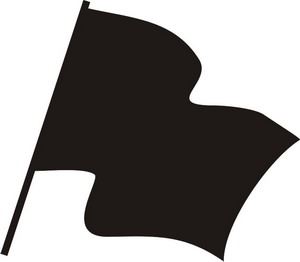 |
Black Flag: Return to the pit area. The black flag is usually shown at the Start / Finish line by the Clerk of Course or his marshal. The flag will be shown whilst your vehicle is being pointed at. This informs the driver they must return to the pit area immediately and report to the Clerk of Course. |
|
 |
Lack of Adhesion: A warning to drivers that there is oil, fluid or some other debris on the track. |
|
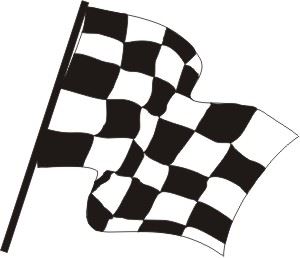 |
Checkered Flag: Denotes end of session. Use the remaining lap to cool the car and return to the pit area. |
At the end of the day
As soon as you’ve finished for the day return your timing device to the timing office. There’s nothing worse than driving half way back to Sydney from Goulburn and being called back!
Remove your race numbers, blue triangle, tow hooks, etc.
Load up the car – this where you’ll really appreciate only bringing the items you actually need!
Check your tire pressures for the drive home and inflate if necessary. It’s not uncommon to let out 10psi during the day, so this will need to be replaced.
Check your oil and coolant one last time for the drive home.
Any questions?
The officials, club committee and club members are there to help, so don't be afraid to approach anyone if you have questions or need some help. Everyone was a beginner at some point!
All content on this site is copyright of the Impreza WRX Club Inc unless otherwise stated.